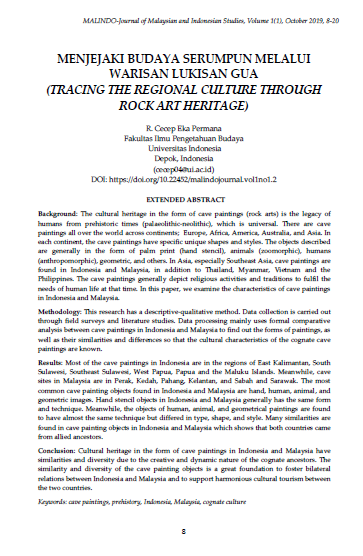MENJEJAKI BUDAYA SERUMPUN MELALUI WARISAN LUKISAN GUA TRACING THE REGIONAL CULTURE THROUGH ROCK ART HERITAGE
Main Article Content
Abstract
Background: The cultural heritage in the form of cave paintings (rock arts) is the legacy of humans from prehistoric times (paleolithic-neolithic), which is universal. There are cave paintings all over the world across continents; Europe, Africa, America, Australia, and Asia. In each continent, the cave paintings have specific unique shapes and styles. The objects described are generally in the form of palm print (hand stencil), animals (zoomorphis), humans (anthropomorphis), geometric, and others. In Asia, especially Southeast Asia, cave paintings are found in Indonesia and Malaysia, in addition to Thailand, Myanmar, Vietnam and the Philippines. The cave paintings generally depict religious activities and traditions to fulfill the needs of human life at that time. In this paper, we examine the characteristics of cave paintings in Indonesia and Malaysia.
Methodology: This research has a descriptive-qualitative method. Data collection is carried out through field surveys and literature studies. Data processing mainly uses formal comparative analysis between cave paintings in Indonesia and Malaysia to find out the forms of paintings, as well as their similarities and differences so that the cultural characteristics of the cognate cave paintings are known.
Results: Most of the cave paintings in Indonesia are in the regions of East Kalimantan, South Sulawesi, Southeast Sulawesi, West Papua, Papua and the Maluku Islands. Meanwhile, cave sites in Malaysia are in Perak, Kedah, Pahang, Kelantan, and Sabah and Sarawak. The most common cave painting objects found in Indonesia and Malaysia are hand, human, animal, and geometric images. Hand stencil objects in Indonesia and Malaysia generally has the same form and technique. Meanwhile, the objects of human, animal, and geometrical paintings are found to have almost the same technique but differed in type, shape, and style. Many similarities are found in cave painting objects in Indonesia and Malaysia which shows that both countries came from allied ancestors.
Conclusion: Cultural heritage in the form of cave paintings in Indonesia and Malaysia have similarities and diversity due to the creative and dynamic nature of the cognate ancestors. The similarity and diversity of the cave painting objects is a great foundation to foster bilateral relations between Indonesia and Malaysia, and to support harmonious cultural tourism between the two countries.
Keywords: cave paintings, prehistory, Indonesia, Malaysia, cognate culture

